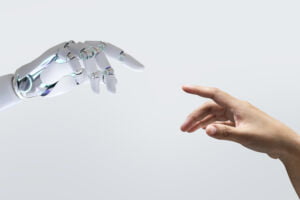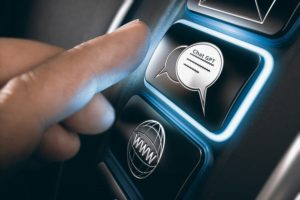Computers have long surpassed humans in addition and subtraction. They play chess, Go, and the most popular computer games like StarCraft or Dota better. They can forecast the weather, play the stock market, and slowly enter our streets, controlling autonomous cars. At the head of the race is the American company OpenAI, whose two models – DALL-E and ChatGPT – are revolutionizing the Internet.

Today, each of us can start generating fantastic images for free by entering a few simple queries. Suppose we want to see a scientist in a spacesuit eating ice cream, only to get breathtaking effects after a while. The solution generates four different images. We can choose the one we like the most and add different variations to it. What if a scientist sat on a giant hamster or took off his spacesuit to show that there was a cat inside?
We are only limited by our imagination. ChatGPT is also shrouded in magic. We can talk to a chatbot almost like with another person, an expert in every field, who knows everything that was happening on the Internet until 2021 (the chatbot was trained on such a set). Whether we need ideas for a party, a dinner recipe, help with homework, debugging code, or checking the weather forecast for tomorrow – we’ll get the answer in seconds. Plus, it will include references to past conversations and updated context.
We are witnessing a revolution in the world of artificial intelligence, but why has it exploded now?
Computing power is growing year by year. Our computers, phones, and even watches are becoming faster. The technology is developing by Moore’s law, which describes the phenomenon of doubling the number of transistors in about 18 months. A great example is the IBM Blue Gene supercomputer, the size of several cabinets. In 2004, it achieved an efficiency of 70 TFLOPS. In comparison, last year’s flagship graphics card can be overclocked to reach 100 TFLOPS. Calculations that until recently required the involvement of research units can now be performed from your room. In addition, computing power has become a commodity that can be freely purchased by the minute.
However, this is only one side of the coin. We also coped with a much better understanding of the language. Computers operate on zeros and ones. We, on the other hand, can program them using languages with a specific syntax, such as python or java. You have to learn it before you start coding. The change that has taken place in recent years is that algorithms have begun to better understand our language. This is a substantial change for technology recipients. Any Internet user can use the chatbot and talk to it like with a friend.

ChatGPT is essentially a large conversational model – a large neural network that has been trained to predict the next word, says Mira Murati, head of technology development at OpenAI.
Thanks to this, we can not only give commands to assistants installed directly on our phones but also expect sensible answers, embedded in the context of our tasks or previous questions. However, suggestions should be approached with a reserve and verified – ChatGPT does not have a monopoly on the truth, on the contrary – it is often wrong.
The third piece of the puzzle is training, which involves analyzing huge amounts of information. In the case of DALL-E, it is nothing more than showing the computer a multitude of images and their descriptions. This is how the network learns that a cat looks different than a dog. However, he understands both animals only as a patchwork of pixels, because he cannot experience the physical world – pet a cat or feed a dog. Years of such learning, however, are enough to generate stunning images.
However, the training base is key to maintaining inclusivity. If we show the algorithm only pictures of the dalmatian, it will not classify the dachshund as a dog. This translates into other elements of our reality. OpenAI explicitly warns that the use of their algorithms may lead to the reinforcement of stereotypes. And so, if we ask DALL-E for photos of the CEO or head of the company, 9 out of 10 photos will show a white man. If we enter the phrase “nurse” in the search field, i.e. a nurse or male nurse (there is no gender distinction here), we will only receive photos of women. Similarly when searching for a plumber, miner, or professor. The effects of the network’s work depend directly on the training data, which is perfectly illustrated by the saying: garbage on the input (i.e. among the training data), garbage on the output (i.e. poor final effect).
Another problem is related to ChatGPT, which is trained on … the Internet. The third version of the tool is based on data produced until 2021, but the integration of the model with Bing is already based on everything available online. That’s why you can ask the assistant in the search engine not only about five things to visit in Paris but also about the score of yesterday’s match.
However, as Aristotle said, “don’t believe everything you read on the Internet.”
While you’ll find information from respected publishers and journalists, you’ll also come across tweets or blog posts that may be not true. ChatGPT is also not always right. It sometimes gets geography or logic wrong. That is why OpenAI has taken a conservative approach to the issues that have inflamed the Internet for years, related to gender and racial equality or minority rights. So, the Americans learned a lesson from the debut of the Tay bot in 2016. Microsoft released it on Twitter, allowing users to freely enter into conversations with other users and learn from them. Unfortunately, Tay soon became an aggressive anti-Semite and racist. Microsoft had to intervene quickly and shut down the bot after 16 hours.
Today, ChatGPT-3 and its newer integration with Bing take a much more careful approach to inflammatory topics and provide the sources they rely on to generate a response (although unfortunately, they sometimes “hallucinate”, manifesting themselves in non-existent sources or twist their content). This is a great illustration of how Microsoft and Google are preparing to arrange new relationships with publishers and content creators. Under the current model, publishers care about ranking as high as possible in search results, because that results in site visits and is the basis of an ad-based business model.
ChatGPT in Bing and Bard, a competing Google service, can turn this model upside down.
Internet users will receive answers to their questions from the chat level, so they will not have to visit other websites. This, of course, assumes that publishers agree to the content of their portals being scanned by artificial intelligence and do not decide to close the content behind a paywall.
ChatGPT will revolutionize not only gathering information, but also the way we work. Already, programmers can use the bot to help find errors in the code, and entrepreneurs can build new solutions by querying the service’s API. Schools will also have to respond to artificial intelligence. Some of them are already banning ChatGPT, instead of adapting the way of teaching to the new realities.
We live in a world that seemed more distant just a year ago. We are standing in the vestibule of the reality portrayed in the film Her, where the main character talked most of the time to a personal artificial intelligence via an earpiece worn in his ear. This one had hundreds of conversations every second and concluded them, learning human nature. ChatGPT was programmed the same way. It is not yet a general artificial intelligence, but its capabilities show how we will interact with technologies in the coming years.
Achieve more by joining the #Edge1Team! Check out our job openings and apply!



